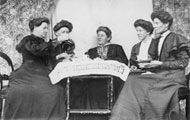Water use in Milllthorpe and District Homes
In the early pioneering days of the Millthorpe district, water was a valuable resource and always used sparingly. Household water was collected from the roofs of the house or shed into an underground brick tank or a square ship’s tank. A hand pump was used to bring water out of the underground tank for domestic use. Later corrugated iron tanks were located next to the house with an outlet tap. Water pipes or taps were not installed in the early homes and water had to be carried into the home by a bucket.
The Laundry
The washing of clothes was a major chore for the women of the household. Washing was done in a tub with a washing board or in a kerosene bucket with a plunger. The invention of the early Vowel Hand Turned Wooden Washing Machine and Wringer was a major labour saving device, but not used in all homes. Large mangles were used to press the water out of the bed sheets and clothes. Delicate clothes were gently wrung by hand to rid the excess water.
By the 1920s, the laundry contained wood-fired coppers set in brick where washing was boiled and lifted out with a 'copper-stick' and then drained. The washing and rinsing of clothes was completed in large cement tubs and squeezed through a hand wringer. Washing was dried on a long wire line held up by timber clothes props. Monday was often the designated 'washing day'.
As electricity was installed, early tub style washing machines with attached wringers were introduced into many homes. By the mid 1950s, the washing was pegged onto a Hills Hoist clothesline for drying. Today, the modern automatic washing machine takes the labour out of the early washing processes. The washing, rinsing and spin-drying are all part a normal washing cycle. Clothes are placed in an electric drier or hung on a clothesline.
The Kitchen
The early pioneering home always had an open fire containing a fountain, buckets and kettles that hung from a hook in the fireplace. These containers supplied hot water for cooking, washing and cups of tea.
Large black iron wood fired stoves were later installed in the kitchen where kettles and pots were constantly on the boil. Dishwashing was done in a tub on the kitchen table using the hot water from the kettles or fountain. Eventually water pipes and taps were installed in the home saving the carrying of water for domestic use. Electricity brought early dishwashers, spin dryers and stoves for cooking. The modern kitchen barely resembles the pioneering kitchen with its dishwashers, refrigerators and electric kettles.
Refrigeration Keeping food fresh was a major problem for the early pioneers. Most rural households had hessian-covered safes, which were placed in a breezeway. The water dripped down all sides of the safe keeping the food cool inside. Butter and cream were often placed in a bucket and lowered down a well for cooling. Before the introduction of refrigerators, ice chests were the only means of keeping food cool. Blocks of ice were delivered to Millthorpe households from the local freezing works to keep food cool.

